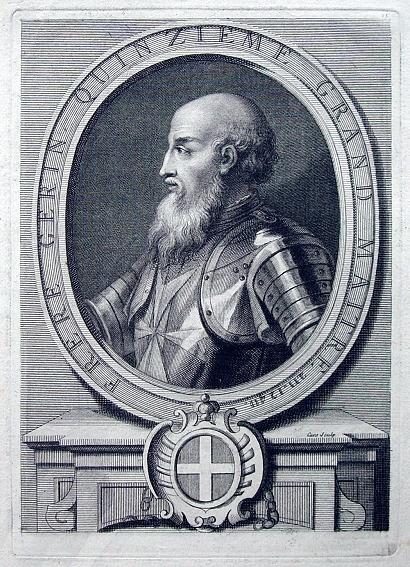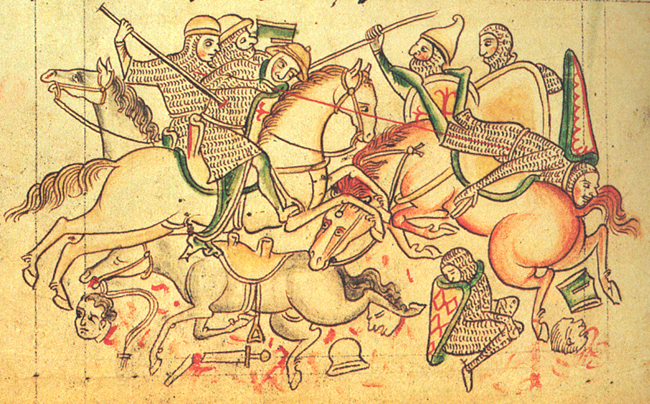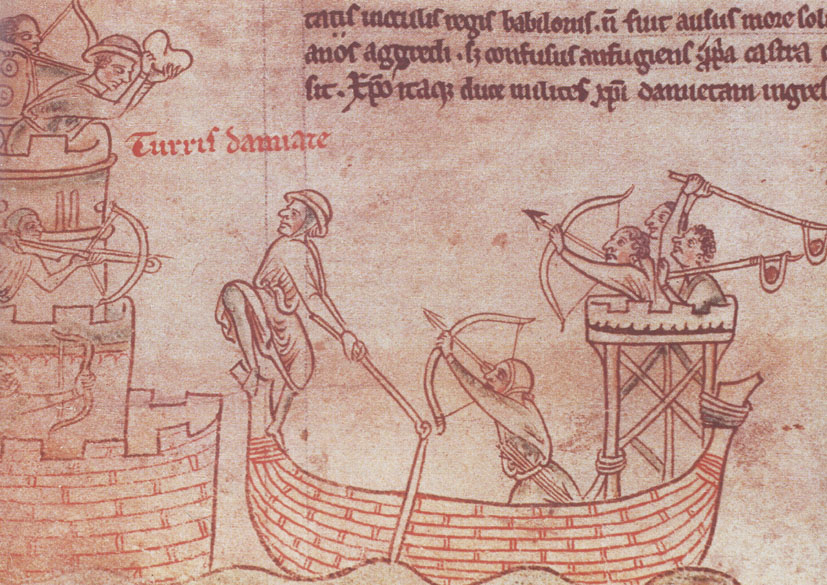|
Siege Of Damietta (1218–1219)
The siege of Damietta of 1218–1219 was part of the Fifth Crusade in which the Crusaders attacked the Egyptian port city of Damietta. The city, under the control of the Ayyubid sultan al-Kamil, was besieged in 1218 and taken by the Crusaders in 1219. At the beginning of the Fifth Crusade, it was agreed that a force would attempt to take Damietta, located at the mouth of the river Nile. The Crusaders then planned to use this city as a launching point for the southern portion of a pincer attack upon Jerusalem from Acre and Suez. Control over the area would also provide wealth to finance the continuation of the crusade, and reduce the threat from the Muslim fleet.Douglas Sterling, "Crusader Siege in the Nile Delta," ''Military History'' 22, no. 5 (August 2005). Preparation In March 1218, the Crusader ships of the Fifth Crusade set sail to the port of Acre. In late May, the forces assigned to besiege Damietta set sail. The first ships arrived on May 27, although the main leaders we ... [...More Info...] [...Related Items...] OR: [Wikipedia] [Google] [Baidu] |
Fifth Crusade
The Fifth Crusade (1217–1221) was a campaign in a series of Crusades by Western Europeans to reacquire Jerusalem and the rest of the Holy Land by first conquering Egypt, ruled by the powerful Ayyubid sultanate, led by al-Adil, brother of Saladin. After the failure of the Fourth Crusade, Innocent III again called for a crusade, and began organizing Crusading armies led by Andrew II of Hungary and Leopold VI of Austria, soon to be joined by John of Brienne. An initial campaign in late 1217 in Syria was inconclusive, and Andrew departed. A German army led by cleric Oliver of Paderborn, and a mixed army of Dutch, Flemish and Frisian soldiers led by William I of Holland, then joined the Crusade in Acre, with a goal of first conquering Egypt, viewed as the key to Jerusalem. There, cardinal Pelagius Galvani arrived as papal legate and ''de facto'' leader of the Crusade, supported by John of Brienne and the masters of the Templars, Hospitallers and Teutonic Knights. Holy Roman Emper ... [...More Info...] [...Related Items...] OR: [Wikipedia] [Google] [Baidu] |
Battle Of Fariskur (1219)
The battle of Fāriskūr was a pitched battle fought between the army of the Fifth Crusade and Ayyubid Egypt on 29 August 1219 outside the Ayyubid encampent at Fāriskūr. It was fought while the siege of Damietta was ongoing. An Ayyubid victory, it had little effect on the course of the war. Decision In February 1219, the Ayyubid sultan, al-Kāmil, retreated from the vicinity of Damietta to Fāriskūr. The crusaders contravallated the city and circumvallated their encampment. There was continuous fighting between them and al-Kāmil's forces. In May 1219, at the suggestion of Cardinal Pelagius of Albano, the crusaders marched on Fāriskūr but the sultan refused to give battle. After the failure of an attempted assault on the walls of Damietta on 24 August, frustration in the crusader ranks reached a tipping point. The infantry and the commoners became sharply critical of the leadership and formed a council, which also included clergy and knights. According to James of Vitry, ... [...More Info...] [...Related Items...] OR: [Wikipedia] [Google] [Baidu] |
William Of Chartres (Templar)
William of (Guillaume de Chartres, Guillielmus de Carnoto, Willemus de Carnoto; c. 1178 – 1218) was the grand master of the Knights Templar from 1210 until 26 August 1218. He was the son of Milo IV, the Count of Bar-sur-Seine. In 1210, William assisted at the coronation of Jean de Brienne as King of Jerusalem. In 1211, he arbitrated between Leo I of Armenia and the Templars, regarding the castle of Bagras. During the Reconquista, he sent needed supplies and reinforcements to the Christian armies. He sent Templars to fight in the Battle of Las Navas de Tolosa and in the 1217 Siege of Alcázar, leading to the order flourishing in Spain, achieving its zenith of influence in the area. He had contact with the Mongols under Genghis Khan and was accused of treason as a result. When the Fifth Crusade started in 1217, William led his men in battle, beginning with the Crusaders launching a siege of the Egyptian city of Damietta. The siege lasted eighteen months, with multiple failed ... [...More Info...] [...Related Items...] OR: [Wikipedia] [Google] [Baidu] |
Guido I Embriaco
Guido I Embriaco or Guy I of Gibelet (born c. 1180; died after September 1238) was "Lord (Signore) of Gib(e)let" or "Gibelletto", the modern and historic Byblos in Lebanon.''Je m'appelle Byblos'', Jean-Pierre Thiollet, H & D, 2005. {{ISBN, 2-914266-04-9. He belonged to the Embriaco family. Life He was the son of Hugh III Embriaco (died 1196) and Stephanie of Milly. Hugo III had been forced to give the Lordship of Gibelet to Saladin in 1187 after being captured by him at the battle of Hattin. Through his mother Stephanie, Guido thus took part in the Crusade of 1197 to retake Gibelet. In 1217, Guido fought alongside Leopold VI, Duke of Austria in the Fifth Crusade and in 1218–1219 he joined the Siege of Damietta in Egypt. He came into conflict with the Ibelin family and thus supported Frederick II in his Sixth Crusade. In August 1228, he took part in the conquest of Nicosia on Cyprus alongside Balian of Sidon. The last document referring to him dates to September 1238. He was su ... [...More Info...] [...Related Items...] OR: [Wikipedia] [Google] [Baidu] |
Guérin De Montaigu
Guérin de Montaigu (died 1228), also known as Garin de Montaigu or Pierre Guérin de Montaigu, was a nobleman from Auvergne, who became the fourteenth Grand Master of the Knights Hospitaller, serving from 1207–1228. He succeeded the Grand Master Geoffroy le Rat after his death in 1206, and was succeeded by Bertrand de Thessy. Biography Guérin de Montaigu was elected Grand Master in the summer of 1207, between 22 May and 1 October. He was Marshal of the Order and participated in the Fifth Crusade. He died a natural death during the reconstruction of the wall of Sidon between 11 November 1227 and 1 March 1228. He was described as "the figure of one of the greatest masters of whom the Hospital has reason to be proud ". Tradition would have it that he was a native of Auvergne and that he was the brother of Pierre de Montaigu, Grand Master of the Knights Templar from 1219 to 1232. Unfortunately, the nobiliaries of Auvergne do not establish to which of the Montaigu families th ... [...More Info...] [...Related Items...] OR: [Wikipedia] [Google] [Baidu] |
Gillis Berthout
{{Infobox noble , name = Gillis Berthout , title = Chamberlain of FlandersLord of Leffinge, Lichtervelde, and Oudenburg (by marriage) , image = , caption = , CoA = Argent, three pales gules , more = no , succession = , reign = , reign-type = , predecessor = , successor = , suc-type = , spouse = Catherina of Bailleul , spouse-type = Married , issue = Gillis, Louis, Elizabeth, Oda , issue-link = , issue-pipe = , full name = , noble family = Berthout , house-type = , father = Walter II Berthout , mother = Goda of Loon, daughter of Louis I, Count of Loon , birth_date = 1175/80 , birth_place = , christening_date = , christening_place = , death_date = 1241 , death_place = , burial_date = , burial_place = , o ... [...More Info...] [...Related Items...] OR: [Wikipedia] [Google] [Baidu] |
Erard II Of Chacenay
Erard II (died 16 June 1236) was the Sire de Chacenay (Chassenay) from 1190/1. He was the eldest son of Erard I of Chacenay and Mathilde de Donzy. Life In 1209 Erard, with the consent of his unnamed wife, confirmed a donation to Basse-Fontaine by a certain ''Agnete'', specified as ''domina'' of Chacenay, probably his grandmother Agnes de Brienne. During the succession crisis of Champagne, Erard was the strongest support of Erard of Brienne-Ramerupt and was the last to reconcile with Blanche of Navarre. Uneasy with the result in Champagne, Erard took part in the Fifth Crusade (1217), but was back in Europe by 1220. In July 1219 Erard's cousin, Hervé, Count of Nevers, confirmed a donation Erard had made to the Teutonic Knights, while Erard was at the siege of Damietta. Upon his return, Erard paid homage to Theobald, Count of Champagne and made a donation to the convent of Argensolles, which had been founded by Blanche of Navarre. He was a patron of the trouvère Guiot de D ... [...More Info...] [...Related Items...] OR: [Wikipedia] [Google] [Baidu] |
Aymar De Lairon
Aymar de Lairon (died 1219), also Adeymar, Adémar or Aimerich, was the lord of Caesarea in jure uxoris, right of his wife from at least 1193 until her death between 1213 and 1216. During this period he was a prominent figure in the Kingdom of Jerusalem. As a widower he became the marshal of the Knights Hospitaller until his own death in battle. Lord of Caesarea Aymar witnessed a charter of Count Henry II of Champagne, husband of Queen Isabella I of Jerusalem, in 1193, subscribing as ''Azemarus Cesariensis dominus'' ("Aymar, Caesarean lord").John L. LaMonte, "The Lords of Caesarea in the Period of the Crusades", ''Speculum'' 22, 2 (1947): 153–54. He subscribed a second royal act with the same title the next year (1194). The wife in whose right he held the title, Juliana Grenier, Juliana, is not herself recorded as the lady of Caesarea until 1197, when together they confirmed a grant made by her brother, Walter II Grenier, Walter II, on his deathbed. Between 1201 and 1213 he and his ... [...More Info...] [...Related Items...] OR: [Wikipedia] [Google] [Baidu] |
Alamanno Da Costa
Alamanno da Costa (active 1193–1224, died before 1229) was a Genoese admiral. He became the count of Syracuse in the Kingdom of Sicily, and led naval expeditions throughout the eastern Mediterranean. He was an important figure in Genoa's longstanding conflict with Pisa and in the origin of its conflict with Venice. The historian Ernst Kantorowicz called him a "famous prince of pirates". Early free-lance career Alamanno came from Genoa's mercantile class, and the earliest record of him dates from 1193, when he joined an ''accomende'', a commercial partnership, directed towards Sicily. In 1204, Alamanno and his son Benvenuto, on their own initiative, set out aboard the ''Carroccia'' in search of the Pisan corsair ''Leopardo''. The ''Carroccia'' and ''Leopardo'' were both classed as ''navi''—broad-beamed, lateen-rigged ships. The former had on board 500 armed men, and the latter probably half as many. The inventory taken after Alamanno successfully captured the ''Leopardo'' and int ... [...More Info...] [...Related Items...] OR: [Wikipedia] [Google] [Baidu] |
Adolf VI, Count Of Berg
Count Adolf VI of Berg (born before 1176 – died 7 August 1218 at Damiette during the Hungarian crusade against Egypt) ruled the County of Berg from 1197 until 1218. Life He was the son of Engelbert I of Berg and Margaret of Geldern, and the oldest brother of Engelbert II of Berg (1185–1225), also known as Engelbert of Cologne or Saint Engelbert. Adolf married Berta von Sayn (died 1244), a daughter of Henry II von Sayn and Agnes zu Saffenberg. They had one daughter: *Irmgard of Berg, heiress of Berg (died 1248–9). She married Henry IV, Duke of Limburg. In 1212 Adolf took part to the Albigensian Crusade against the Cathars. And in 1215 he took over the Kaiserpfalz Kaiserswerth. Adolf left on 1218 with the Fifth Crusade to Egypt and died on 7 August 1218 of a plague as commander of the Lower-Rhenish and Frisian troops in Damiette, in the delta of the Nile. His brother, the Archbishop Engelbert II of Berg followed him as ruler of Berg, which later went to the husban ... [...More Info...] [...Related Items...] OR: [Wikipedia] [Google] [Baidu] |
Feast Of The Purification
Candlemas (also spelled Candlemass), also known as the Feast of the Presentation of Jesus Christ, the Feast of the Purification of the Blessed Virgin Mary, or the Feast of the Holy Encounter, is a Christian holiday commemorating the presentation of Jesus at the Temple. It is based upon the account of the presentation of Jesus in Luke 2:22–40. In accordance with Leviticus 12, a woman was to be purified by presenting a lamb as a burnt offering, and either a young pigeon or dove as sin offering, 33 days after a boy's circumcision. It falls on 2 February, which is traditionally the 40th day (postpartum period) of and the conclusion of the Christmas–Epiphany season. While it is customary for Christians in some countries to remove their Christmas decorations on Twelfth Night (Epiphany Eve), those in other Christian countries historically remove them after Candlemas. On Candlemas, many Christians (especially Eastern Orthodox, Roman Catholics, Lutherans, Anglicans and Methodists) ... [...More Info...] [...Related Items...] OR: [Wikipedia] [Google] [Baidu] |





